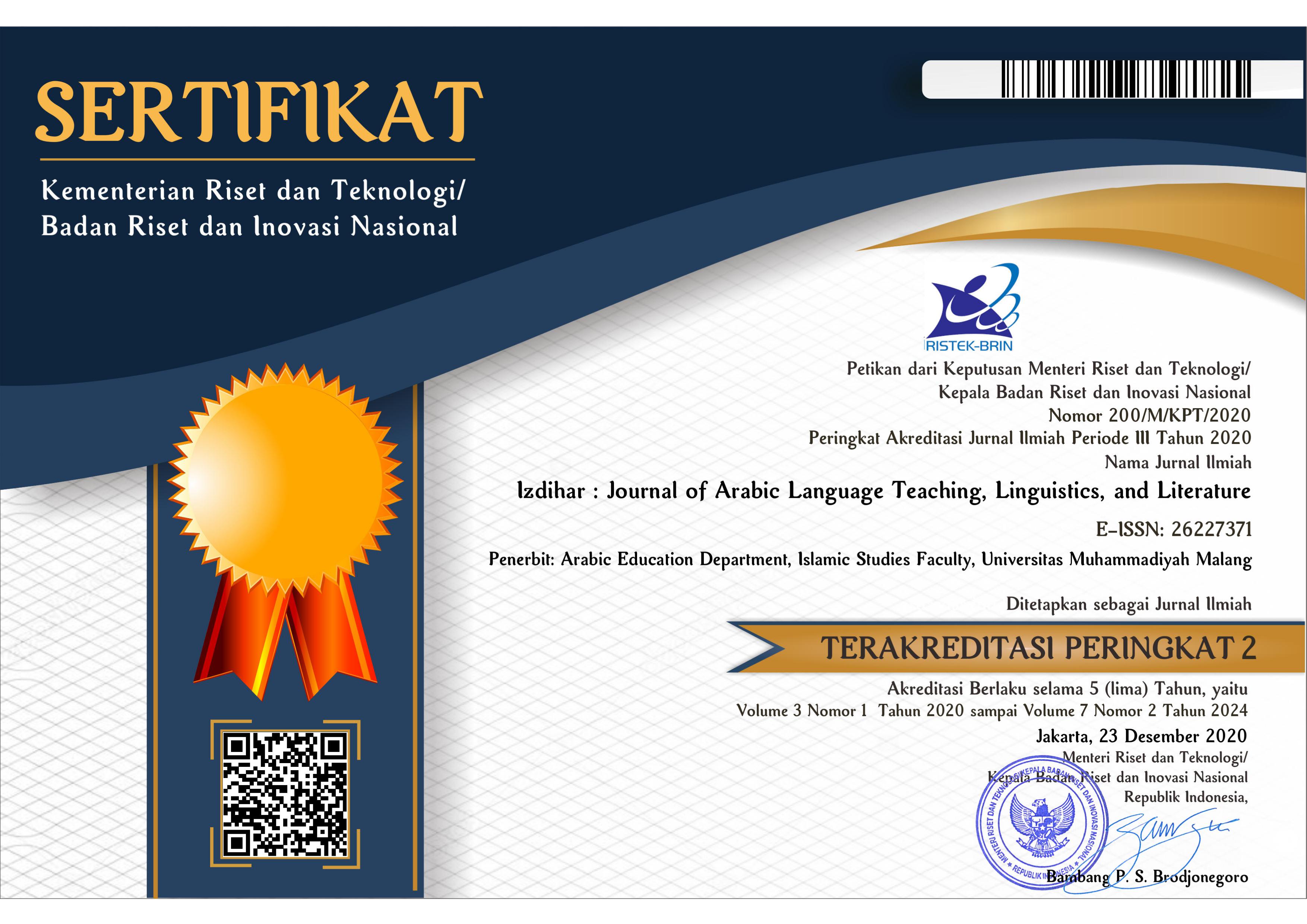Arabic-Java Writing System: How Javanese Language Adopts Arabic Script
DOI:
https://doi.org/10.22219/jiz.v4i1.11337Keywords:
Arabic script, Arabic-Java orthography, grapheme, phonemeAbstract
Borrowing script happens throughout history of languages. Long before we know Latin script, Javanese has already adopted Arabic script. However, Java language deals with problematic adaptation due to distinctive sound system among those two languages, Arabic and Java. For that matter, this research aims to uncover 1) how Arabic-Java orthography represents Javanese’s consonants and vowel, and 2) how Arabic-Java orthography represents Javanese’s cluster. This research uses qualitative descriptive method. Data contain with the Javanese words which is written in Arabic script. Data are gained from eight different books which are inscribed by Arabic-Java orthography. After data are collected, the orthography method and grapheme-phoneme correspondence are used to analyze them. Grapheme-phoneme correspondence used to know how Arabic-Java orthography represents consonants and vocal phonemes. Finally, this research found that Arabic-Java orthography has 28 graphemes which are used to represent 23 consonants. Modification letters and digraph are used to represent missing sound in Arabic. Six Javanese vocals are represented with 9 graphemes. In another hand, cluster is written in two ways, first by adding Anaptyxis schwa [ə] in between sonorant-sonorant or obstruent-sonorant and vowel [a] in initial cluster nasal consonant and plosive consonant.
Downloads
References
‘Ulyan, M., Budiyanti, N., & Nugraha, S. (2020). Islamic education based on arabic pegon letters in Madrasah Diniyah Al Barokah Watuagung Tambak Banyumas. Jurnal Iqra’ : Kajian Ilmu Pendidikan, 5(1), 133–134. DOI: https://doi.org/doi.org/10.25217/ji.v5i1.576
Aswadi. (1994). Huruf Arab Dalam Lintasan Sejarah.
Aswadi. (1995). Rekonstruksi kaidah penulisan naskah jawa dengan huruf Arab.
Coulmas, F. (1989). The blackwell encyclopedia of writing systems. Blackwell.
Coulmas, F. (2000). The writing systems of the world. Blackwell.
Coulmas, F. (2002). Writing systems an introduction to their linguistics analysis. Cambridge University Press.
Dani, I. S. (1997). Al-Muḥkam fῑ naqt al-maṣāḥif. Dārul Fikr al-Mu’āṣir.
Daniel, P. T. (1996). The world’s writing systems. Oxford Univesity Press.
Daniels, P. T. (2006). On beyond alphabets. Written Language and Literacy, 9(1), 7–24.DOI: https://doi.org/10.1075/wll.9.1.03dan
Elhija, A. (2014). A new writing system ? Developing orthographies for writing Arabic dialects in electronic media. Writing System Research, 6(2), 37–41. DOI: https://doi.org/10.1080/17586801.2013.868334
Ghorbanpour, A., & Kambuziya, A. K. Z. (2019). Loanword Syllable Adaptation in Persian : An Optimality-Theoretic Account. Journal of Universal Language, 20(2), 95–127. DOI: https://doi.org/10.22425/jul.2019.20.2.95
Hamid, A. (1996). Basyā‘irul khairat. Jannatul Ma‘wa.
Hizbullah, N., Suryaningsih, I., & Mardiah, Z. (2019). Manuskrip Arab di nusantara dalam tinjauan linguistik korpus. Arabi:Journal of Arabic Studies, 4(1), 65–74. DOI: http://dx.doi.org/10.24865/ajas.v4i1.145
House, M., & Mirdehghan, M. (2011). Persian, Urdu, and Pashto: A comparative orthographic analysis. Writing System Research, 2(1), 9–23. DOI: https://doi.org/10.1093/wsr/wsq005
Ihsan, M. (n.d.). Risālatul maḥῑḍ. Menara Kudus.
Kridalaksana, H. (1982). Kamus linguistik. PT Gramedia Jakarta.
Kurzon, D. (2013). Diacritics and the Perso-Arabic script. August 2014, 37–41. DOI: https://doi.org/10.1080/17586801.2013.799451
Maghfuri, M. (n.d.). al-Mar‘ah as-Ṣāliḥah. al-Hikmah.
Mahammad, A. bakar. (1966). ‘Iḍāh mawā’izil ‘uṣfῡriyah. Menara Kudus.
Mahfud, S., & Zuhdy, H. (2018). Kitābatu ‘Arab pegon ḥaṣā’iṣuha wa ishāmātuhā fῑ taṭwῑri ta’lῑmi al-lugah Al-‘arabiyah bi Indῡnῑsiyā. Arabiyat: Jurnal Pendidikan Bahasa Arab Dan Kebahasaaraban, 5(2), 315. DOI: http://dx.doi.org/10.15408/a.v5i2.7446
Mahmoud-Mukadam, A.-R., & Adebisi, A. A. (2019). Language borrowing between Arabic and Yoruba language. Izdihar, 2(1), 53–66. DOI: https://doi.org/10.22219/jiz.v2i1.7386
Major, R. C., & Crystal, D. (1992). A dictionary of linguistics and phonetics. In The Modern Language Journal (Vol. 76, Issue 3). DOI: https://doi.org/10.2307/330198
Marsono. (1992). Sistem konsonan dalam bahasa Jawa.
Mastoyo, T. (2007). Pengantar (metode) penelitian bahasa. Caransavatibooks.
Meletis, D. (2019). The grapheme as a universal basic unit of writing. Writing System Research, 11(1), 26–49. DOI: https://doi.org/10.1080/17586801.2019.1697412
Misbah, Z. al-M. (1422). Masā‘ilur rijāl. al-Balag.
Mustofa, B. (1381). Naẓamus sullamil munawaraq. Menara Kudus.
Noordyanto, N., Studi, M., & Komunikasi, D. (2016). Tipografi Arab pegon dalam praktik berbahasa Madura. Jurnal Desain Komunikasi Visual, 9(2), 28–53. DOI: https://doi.org/10.24821/dkv.v9i2.1763
Raffles, T. S. (2014). The history of Java. Narasi.
Ratcliffe, R. R. (2001). What do “ phonemic ” writing systems represent ? Principle. Writing System Research, 4(1), 1–14. DOI: https://doi.org/10.1075/wll.4.1.02rat
Revell, E. J. (1975). The diacritical dots and the development of the Arabic alphabet. Journal of Semitic Studies, 20(2), 178–190. DOI: https://doi.org/10.1093/jss/XX.2.178
Rogers, H. (2005). Writing systems a linguistic approach. Blackwell.
Ryding, K. C. (2005). A reference grammar of modern standard Arabic. Cambridge University Press.
Sampson, G. (2014). Writing Systems: methods for recording language. In Keith Allan (Ed.), Routledge Handbook of Linguistics. Routledge.
Sebba, M. (2011). Sociolinguistic approaches to writing systems research. Writing System Research, 1(1), 37–41. DOI: https://doi.org/10.1093/wsr/wsp002
Sina, I. (n.d.). Abābu ḥudῡtsil ḥurῡf. Maṭbu’āt Majma’ al-Lugah al-‘Arabiyah.
Usman, M. (n.d.). I’ānatun nisā‘. Ḥuqῡq at-Țab’ wa an-Nasyr Maḥfuẓah.
Wedhawati et al. (2006). Tata bahasa Jawa mutakhir. Kanisius.
Wedhawati, Marsono, Edi Setiyanto, Wiwin, Restu, & Praptomo. (2006). Tata bahasa Jawa mutakhir. Penerbit Kanisius.
Zoetmulder, P. J., & Poedjawijatna, I. R. (1992). Bahasa Purwa 1. Gadjah Mada University Press.
Downloads
Published
How to Cite
Issue
Section
License
Copyright (c) 2021 Fakron Jamalin and Izdihar: Journal of Arabic Language Teaching, Linguistics, and Literature

This work is licensed under a Creative Commons Attribution-ShareAlike 4.0 International License.
Copyright Notice
Authors who publish with this journal agree to the following terms:
- Authors retain copyright and grant the journal right of first publication with the work simultaneously licensed under a Creative Commons Attribution-ShareAlike 4.0 International License that allows others to share the work with an acknowledgment of the work's authorship and initial publication in this journal.
- Authors are able to enter into separate, additional contractual arrangements for the non-exclusive distribution of the journal's published version of the work (e.g., post it to an institutional repository or publish it in a book), with an acknowledgment of its initial publication in this journal.
- Authors are permitted and encouraged to post their work online (e.g., in institutional repositories or on their website) prior to and during the submission process, as it can lead to productive exchanges, as well as earlier and greater citation of published work (See The Effect of Open Access).
Copyright (c) 2019 Izdihar : Journal of Arabic Language Teaching, Linguistics, and Literature

This work is licensed under a Creative Commons Attribution-ShareAlike 4.0 International License.

















